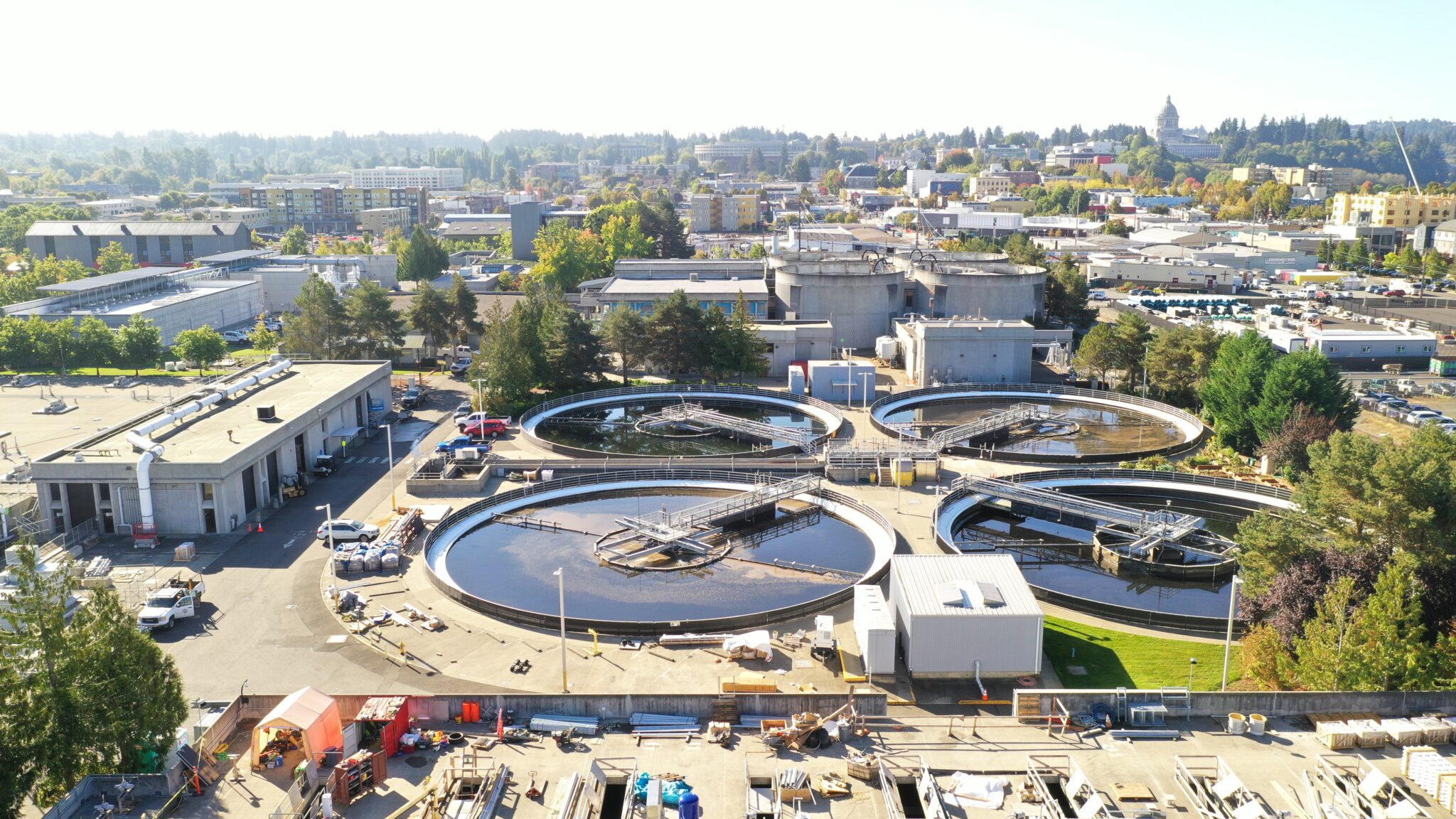
LOTT Clean Water Alliance provides wastewater treatment and water reclamation services for nearly 120,000 residents in Lacey, Olympia, Tumwater, and Thurston County, WA. The non-profit, formed by four government partners, is recognized locally, regionally, and nationally as an industry leader in progressive treatment approaches that meet some of the most stringent discharge limits in the United States. LOTT operates the Budd Inlet Treatment Plant, which was built in the early 1950s in downtown Olympia, Washington.
The Washington State Department of Ecology has initiated a general permit process that will eventually require all 84 wastewater treatment plants discharging into the Puget Sound to implement biological nutrient removal (BNR). BNR is an important treatment process to reduce nitrogen in wastewater effluent. This process reduces nutrient loading in receiving water bodies, which can cause harmful algal blooms and low oxygen levels in the marine ecosystem.
LOTT has been performing nutrient removal since a plant upgrade in 1994, making them one of the only wastewater treatment plants providing nutrient removal on Puget Sound. In 2020, LOTT began construction on a large-scale project to upgrade their nutrient removal process. LOTT partnered with Parametrix to design this new “second generation” BNR upgrade and associated process improvements at the Budd Inlet Treatment Plant. This project required a significant investment to plan, design, and construct the needed facility changes, and included converting the first aeration basin into a BNR basin. The project also replaced aging equipment, like over-sized blowers, and increased process reliability by enhancing operational flexibility with new instrumentation and controls equipment.
As a result of these improvements, the Budd Inlet Treatment Plant further advanced their nutrient removal processes. The first phase of the nutrient removal upgrade was completed early in 2022, with impressive results – nitrogen levels are tracking at around 1 mg/L of total inorganic nitrogen (TIN), compared to their seasonal permit limit of 3mg/L. These low numbers are more impressive given they occurred early in the year when compliance for TIN is most challenging due to higher flows and loads along with lower water temperatures. LOTT’s enhanced nutrient removal positions the utility for more stringent permit limits in the future. As an industry leader, they share knowledge and demonstrate to other utilities that nutrient reduction can be achieved.
When complete, the world class upgrades will improve treatment process reliability, significantly reduce energy usage, and contribute to overall system capacity. By using highly efficient pumps, enhancing aeration control, and using the latest in instrumentation and controls technology, energy savings are projected at 2.2 million kilowatt-hours per year – equivalent to a savings of $145,000 annually for LOTT

During preliminary and detailed design, Parametrix worked closely with the LOTT staff utilizing LOTT’s adopted integrated team delivery approach. The multi-year design process included staff from throughout the organization to ensure full consideration of operational and maintenance issues. These integrated team delivery meetings meant that staff members who will be the end users of the upgraded facility have an opportunity to provide meaningful input during the development of the design (as opposed to seeing only the design submittals), minimized rework from one formal design submittal package to the next, and helped ensure the design took advantage of the wealth of knowledge and experience offered by LOTT’s plant staff. In this way, LOTT staff, end users, and Parametrix were all heavily invested in the long-term success of the project.
The project was a multidisciplinary effort with innovative treatment processes implemented to increase efficiency and provide plant operational flexibility. This project uses new large-bubble mixing technology that is the first of its kind on the West Coast. The new technology uses only 10 percent of the power of the mixing system it replaced.

In March of 2020, as the project entered the most intensive stage of final revisions and production, many Parametrix and LOTT staff began working remotely due to the pandemic. In order to have sufficient time for bidding and construction, LOTT had strict milestones they needed to meet. The team adapted quickly and delivered the entire package on April 13, 2020 – right on time.

To get a sense of the enormity of project, this 3D model-based design (shown above) resulted in almost 300 plan sheets covering many disciplines and three volumes of specifications requiring 22 boxes and an F-250 pickup truck to deliver the final bid package!
LOTT used the final design package and an alternative contractor procurement process to solicit quotes from three pre-qualified contractors and initiated construction in November 2020. During construction of Phase 1, Parametrix and LOTT staff have continued to work closely together. Both entities have been attending regular meetings to discuss general construction status, coordinate timing for necessary shutdowns, minimize process impacts from construction activities, complete startup and commissioning of Trains 4 and 5, as well as programming and controls. In November 2021, the initial startup, testing, and commissioning Phase 1 (of 3) was initiated and finished in January 2022. The project is currently constructing Phase 2 (Train 3).
Throughout all three years of construction of these improvements, the treatment plant must remain operational and continuously meet permit limits. Construction of the improvements has been carefully phased to ensure there is no downtime in treatment. LOTT’s Executive Director told the Board, “It is a lot like gutting your kitchen and remodeling while still preparing three meals a day for your growing family.”
The new facility will allow the surrounding community to continue to grow and flourish while simultaneously reducing the emissions and water quality impacts to the receiving waters of Budd Inlet and the entire South Puget Sound. This project is a shining example of how this integrated delivery approach led to a better design, construction, and commissioning process that meets LOTT’s long-term permit requirements, as well as improving their operations and energy efficiency overall.


